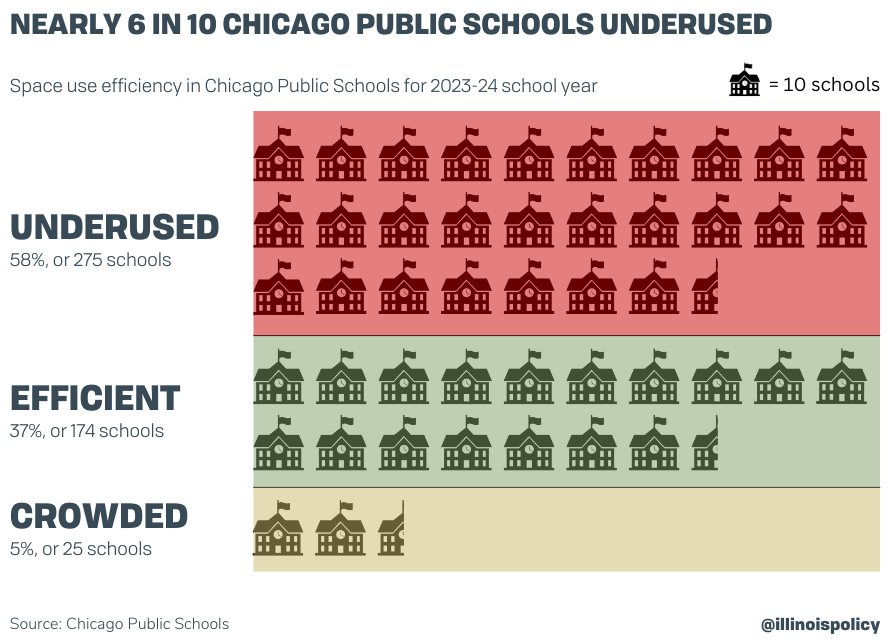3-in-10 seats are empty at Chicago Public Schools
Hundreds of Chicago Public Schools buildings have a space-use problem – they’re too empty. Nearly 60% of schools are underutilized while 5% are overcrowded. Only 37% are at ideal capacity. The Chicago Teachers Union wants to add staff to the empty schools.
When students return to Chicago Public Schools on Aug. 26, they are likely to see empty desks near them.
More than 3 in 10 seats in CPS schools remained empty during the 2023-2024 school year. In many schools the rate was higher.
Space utilization is measured annually by the district, which reports on school buildings operated by CPS, excluding charter schools operated in their own buildings and alternative schools. An elementary school’s ideal capacity is 77% of its maximum capacity and a high school’s is 80%.
Data shows 58% of schools – or 275 schools – were underutilized in the 2023-2024 school year, 37% were efficient and 5% were overcrowded. Seven of the 25 overcrowded schools are selective enrollment schools which the Chicago Board of Education has resolved to close. Meanwhile, only one “sustainable community school” – the Chicago Teachers Union’s favored but poor-performing school model – is overcrowded.

The average “space utilization rate” in the 2023-2024 school year is 65% across 474 schools analyzed from district data. That means the average school in CPS has 35% of its seats unfilled.
Despite under-enrollment in many CPS schools, the Chicago Teachers Union’s leaked contract demands include mandates for eight new staff members at each school in CPS at an additional cost to the district of $1.7 billion.
Emptiest schools in CPS also have low proficiency rates
The 10 least-utilized schools in CPS were at just 12% capacity on average, ranging from 4% at Douglass Academy High School to 16% at Sumner Elementary School.
There were two staff members for every seven students at those schools on average.
But a lower staff-to-student ratio hasn’t helped those students, with those schools seeing high absenteeism rates and low proficiency rates.
Over 61% of the already few students were chronically absent, with as many as 84% chronically absent at Austin College and Career Academy High School alone.
The average percentage of students meeting grade-level standards in state assessments for reading and math was 9% and 2% in spring 2023 for those 10 schools. In three of the schools, no tested students met proficiency in reading and five of the schools saw no tested students meet proficiency in math.
Costs soared at those schools. Average spending per student was $34,642 compared to the district average of $18,287. That’s over $16,000 more per student at the 10 emptiest schools for much poorer results than the district’s average.
The least utilized school in CPS is Douglass Academy High School. It’s at just 4% of its capacity and enrolled 35 students in the 2023-2024 school year. It employs 21.5 full-time staff members for a staff-to-student ratio of 3:5. Reading and math proficiency rates were redacted in spring 2023 because of the Illinois State Board of Education’s rules for results involving fewer than 10 students. But the most recent test data available shows no 11th grade students could read or perform math at grade level on the SAT in the 2021-2022 school year, and 86% of tested students scored in the lowest proficiency level for reading. Douglass Academy’s chronic absenteeism rate was 64%.
These poor metrics came at a price tag of $68,091 per student in site-based expenditures. That’s nearly $50,000 more per student than the district average.
That spending encompasses “site-based expenditures,” which are defined as “the total of per-pupil school-level expenditures and per-pupil centralized expenditures funded by federal and state/local source of funds.” Those expenditures include the cost of school staff, transportation and central office staff. It does not include capital expenditures or the cost of the school building.
Most overcrowded schools in CPS do better than the emptiest schools
There were more successful outcomes and efficient spending among the 10 most overcrowded schools in CPS compared to the 10 emptiest schools.
The 10 most overcrowded schools in CPS averaged 137% of their capacity met, ranging from 126% at William Howard Taft High School to 148% at Robert A. Black Elementary School. On average across the 10 schools there was one staff member for every nine students.
Chronic absenteeism was 36%, lower than the district average and lower than in the 10 emptiest schools. The highest chronic absenteeism rate among the most-crowded schools was at Hubbard High School with 67% of their 1,673 students chronically absent.
The average percentage of students meeting grade-level standards in state assessments was 46% for reading and 36% for math in spring 2023, also better than at the 10 emptiest schools.
Average site-based spending per student was $16,655, which averages $20,000 less per student than at the 10 emptiest schools.
The most overcrowded school in CPS was Robert A. Black Magnet Elementary School. It has surpassed its capacity at 148% space utilization and enrolls 356 students with 43 teachers, for a staff to student ratio of 1:8.
In spring 2023, 51% of its students in third through eighth grade met grade-level standards in reading, exceeding the district average, and 17% in math, less than the district average. It had a low absenteeism rate at 11% and spending per student surpassed the district average by nearly $2,000 to clock-in at $20,121 spending on site-based expenditures per student.
CTU wants more staff members, even at empty and severely underenrolled schools
District reports show enrollment at CPS dropped by 31,905 students between the 2019-2020 and 2023-2024 school years.
Reports show employment in CPS has increased by the equivalent of 5,472 full-time staff members between December 2019 and December 2023. That’s a 15% increase in full-time staff members despite a 9% decrease in enrollment.
Yet for its new contract CTU is demanding at least eight additional staff members at each CPS school, even the schools where more than half of the seats are empty.
The new positions include: librarian, librarian assistant, social worker, newcomer liaison, case manager, restorative justice coordinator, reading specialist and interventionist (elementary schools), three elective teachers (middle schools), technology coordinator, “climate champion,” and gender support coordinator and/or LGBTQ+ lead/specialist and option to expand LGBTQ+ faculty support teams at each school.
While nearly three-quarters of students in CPS can’t read or do math at grade level, CTU leadership is pushing a lengthy list of costly demands. Many of these demands don’t impact learning in the classroom, such as $2,000 payments to asylum seekers, subsidies for weight-loss surgery and drugs, and environmental initiatives such as an electric school bus fleet. District spending keeps expanding rapidly as academics continue to drop, meaning money is failing to improve learning within the dysfunction forged by CTU.
Chicagoans and CPS parents are already concerned about “students not learning enough academically” in CPS. CTU seems determined to get its expensive demands regardless of what it does to students’ futures or Chicago taxpayers’ wallets.
